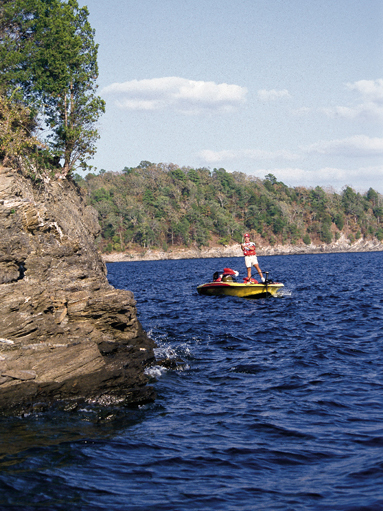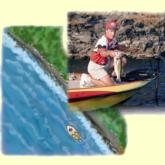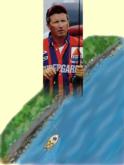Cliffhangers

When towering bluffs mean big bass
Success on bluff banks is largely a matter of timing. Wal-Mart FLW Tour anglers Dion Hibdon of Stover, Mo., and Terry Bolton of Paducah, Ky., chisel bass off rock walls from fall through early spring while Craig Powers of Rockwood, Tenn., plays the current in the summertime.
Most deep, clear impoundments feature bluff banks that plummet into deep water. If you’ve ever visited Bull Shoals, Table Rock, Fort Loudoun or countless other lakes that feature these picturesque rock walls, you probably couldn’t resist fishing them. If you hit these structures at the wrong time, or employed unsuitable approaches, you probably caught few bass.
Don’t be discouraged. These vertical walls can fill your livewell with quality fish. Hibdon and Bolton begin to score well on bluffs in late October to early November when the water cools, and they continue doing so until the bass move shallow to spawn the following spring.
Bluff banks provide bass with fast access to deep and shallow water. By moving vertically up or down, they can go from 20 feet or deeper to five feet in a matter of seconds without leaving the security of nearby cover. This short commute appeals to bass during cold-water periods when a low metabolic rate makes them sluggish and more inclined to conserve energy. In contrast, bass stationed on the ends of long points or on offshore ledges have to make a long haul to reach shallow feeding areas.
Main lake bluffs adjacent to the river channel generally produce more consistent catches, particularly bluffs on the lower ends of impoundments, which typically hold the clearest water. Bluff banks in major creeks that have deep creek channels can also be productive.
 “I usually prefer main lake bluffs because they’re more open to the wind,” Bolton says. “I think a choppy surface helps the bite.”
“I usually prefer main lake bluffs because they’re more open to the wind,” Bolton says. “I think a choppy surface helps the bite.”
As with any structure, it is crucial to determine the key areas that hold bass. Why waste time working a mile-long bluff when you can concentrate your efforts on two or three short stretches that attract most of the fish?
“I catch a lot of bass from swings in the bluff,” Hibdon says. “Wherever the river channel swings away from the bank, there will be a ledge and usually a change in the bottom composition. Normally, you’ll see a distinct bank change. It may go from a sheer rock wall to broken rock, or it may even go all the way from rock to gravel.”
Even though some bluffs lie adjacent to extremely deep water, Hibdon catches most of his bass from these swings in water only 10- to 15-feet deep. He positions his boat close to the wall at the edge of the ledge and casts to the bank at about a 45-degree angle.
“That little shelf is what holds them,” Hibdon says. “When you’re a boat length away from the bank, it’s common to be sitting right over the ledge in 15 feet of water. If you move two boat lengths away from the bluff, you could be over 60 feet of water.”
With spinning tackle and 10-pound test monofilament, Hibdon fishes a skirted 1/4- or 1/8-ounce Gambler Ninja Jig tipped with a small plastic crawfish, either a Guido’s Baby Original or a Baby Bug. He trims the weed guard to insure solid hookups, since snagging isn’t much of a problem. Productive colors include green pumpkin, melon pepper and brown with a pumpkin trailer. He favors the later combination more in early spring.
 “Most of the time I throw the jig right in on the bank,” Hibdon says. “Then I let it fall right down the side of the bluff. When it hits bottom, I let it sit there for just a second, then I ease it off of that shelf and let it fall straight down to the next shelf. As soon as you pull the jig off a shelf, that’s when you normally get bit.”
“Most of the time I throw the jig right in on the bank,” Hibdon says. “Then I let it fall right down the side of the bluff. When it hits bottom, I let it sit there for just a second, then I ease it off of that shelf and let it fall straight down to the next shelf. As soon as you pull the jig off a shelf, that’s when you normally get bit.”
Other prime areas along bluffs are rockslides, subtle points and pockets, and any windfalls or other cover along the water’s edge. Bass on bluffs also relate to logs and debris that collects in the back of small pockets. These protected indentations provide bass with ideal feeding stations.
Bolton has done especially well fishing such pockets early in the spring. He slow rolls a 1/2- to 3/4-ounce spinnerbait to depths of 15 feet next to fallen trees that angle sharply into the water. He rigs the spinnerbait with No. 2 and No. 4 Colorado blades, which are small relative to the weight of the spinnerbait.
“The banks are steep, even in the back of those pockets,” Bolton says. “You need small blades to let the bait get down fast. I caught them once fishing the back of pockets on Table Rock. I’d throw the spinnerbait next to a log, engage the reel and almost let the bait free fall down the length of the trunk.”
When fishing this pattern, Bolton often does a turnabout and targets bluffs in the major river or rivers feeding the lake. He continues upriver until he notices a discernible change in the water color, from clear to stained. Any bluffs he finds in this area are likely to harbor aggressive bass. They respond well to a silver and gold blade combination with a white/chartreuse skirt. He fishes all of his spinnerbaits on 14- to 17-pound Stren Super Tough line.
The one time Bolton will fish the entire length of a bluff, including its sheer walls, is when waves crash into the bank and put bass on the feed. This pattern produces best when bass first flock to bluffs in the fall, before the water becomes so cold it slows their feeding activity. If the sky is overcast and spitting rain, so much the better.
Here again, Bolton opts for a 1/2- to 3/4-ounce spinnerbait, but in this instance he goes with No. 3 and No. 4 willow leaf blades and burns the spinnerbait tight and parallel to the wall.
“I’ll either bulge the surface with the blades or run the spinnerbait four to five feet deep,” Bolton says. “My boat is often close enough to the bluff that I can reach out and touch it with my six-foot, six-inch baitcasting rod. When the wind and waves are pounding the bank, you have to stand on the trolling motor to keep the boat from scraping the rocks.”
Bolton usually burns bluffs in clear water on the lower ends of impoundments. Here he favors shad colors, such as silver blades and a white or clear metal flake skirt.
When bass on bluffs ignore his spinnerbaits, Bolton flips and pitches a 1/2-ounce jig dressed with a Riverside Big Claw. He drops the jig at the water’s edge and lets it free fall. Many strikes come on the initial drop.
“When the water’s cold, you don’t want to get in a hurry,” Bolton says. “That’s really important. Put the trolling motor on low speed and pull out a little line as the jig falls to keep it close to the wall. If you fish too fast, you’ll miss those bass. I often find them suspended next to little ledges five to 10 feet deep.”
The fish tend to be shallower on overcast days and deeper when the sun shines. On sunny days, Bolton may back off a little farther and make longer casts. This allows him to let his jig sink deeper to reach bass that may be holding 15 to 20 feet down. Brown/orange, black/blue and black/pumpkin/chartreuse are Bolton’s primary jig colors.
 Not all bluff fishing opportunities occur during the cold months. Powers, who is fast making a name for himself on the Wal-Mart FLW Tour, hits rock walls hard in the summertime when he fishes power-generating impoundments that support spotted bass. Late in the morning, when the dam starts sucking water to supply power to countless air conditioners, Powers heads for rocky bluffs. He knows the current will pull spotted bass tight to the walls and put them on the feed.
Not all bluff fishing opportunities occur during the cold months. Powers, who is fast making a name for himself on the Wal-Mart FLW Tour, hits rock walls hard in the summertime when he fishes power-generating impoundments that support spotted bass. Late in the morning, when the dam starts sucking water to supply power to countless air conditioners, Powers heads for rocky bluffs. He knows the current will pull spotted bass tight to the walls and put them on the feed.
Powers runs his electric motor on high speed as he works upstream against the current. As his boat continuously moves ahead within 20 feet of the wall, Powers flips a 1- to 1 1/4-ounce white jig tipped with a white pork or plastic trailer. The boat may be over 20 to 40 feet of water, but the bass are shallow.
“Just flip the jig against the rocks and hold the rod dead still as the bait falls,” Powers says. “If you don’t have a bite by the time the jig swings out to the boat, flip it back to the rocks. When one bites, you’ll know it.”
Night bluff bite
In the summertime, Dion Hibdon generally fishes bluffs during daylight hours. Nighttime is another matter. You may think anyone who competes in bass tournaments for a living wouldn’t lose sleep night-fishing for fun, but Hibdon still enjoys bass fishing for the pure pleasure it brings.
“Bluffs are extremely good at night on places like Bull Shoals,” Hibdon says. “And nobody messes with them. The best bluffs are those that have standing trees and other wood cover on them. You can really bust them with a black 10-inch worm in places like that after dark.”
Hibdon fishes the big plastic bait with a 3/16-ounce sinker to impart a slow fall. He fishes tight, slowly crawls the worm over ledges and hangs heavyweight bass that move in to prowl during the midnight hours.